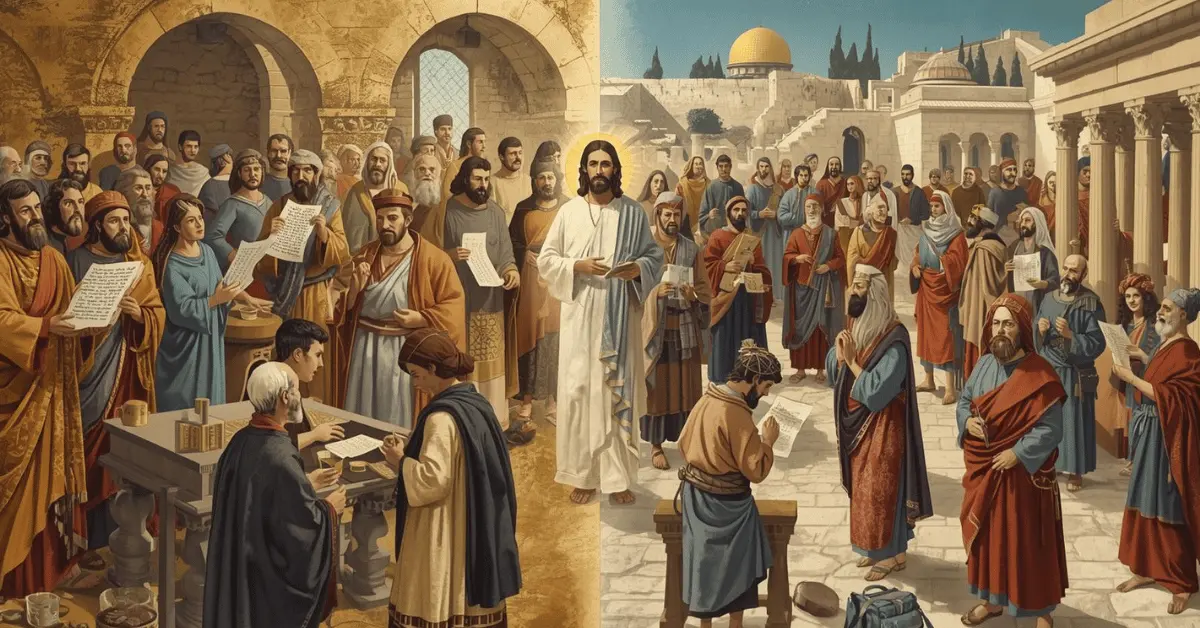When reading the New Testament, two influential Jewish groups appear frequently: the Pharisees and the Sadducees. They were central to the religious and political climate during the time of Jesus, yet their beliefs, influence, and roles were far from identical.
“The Pharisees and Sadducees both claimed to follow God — yet their hearts stood worlds apart. Their story still whispers a warning for us today.”
Historical Background of the Pharisees and Sadducees
Both groups rose to prominence during the Second Temple period, but they represented very different approaches to Jewish law, politics, and society.
Roots of the Pharisees
The Pharisees emerged as a group deeply committed to preserving Jewish traditions. They believed in both the written Torah (the first five books of the Bible) and the oral law (interpretations and traditions passed down by Jewish teachers).
Origins of the Sadducees
The Sadducees, on the other hand, were primarily from aristocratic and priestly families. They held positions of power in the Temple and were often associated with wealth and political influence.
Core Beliefs: A Side-by-Side Look
The sharp differences between these two groups become even clearer when examining their religious convictions.
Pharisees’ Doctrines
- Believed in the resurrection of the dead.
- Accepted angels, spirits, and the afterlife.
- Upheld the oral traditions alongside Scripture.
- Focused on personal piety and purity laws that extended beyond the Temple.
Sadducees’ Doctrines
- Denied the resurrection of the dead.
- Rejected belief in angels or spirits.
- Accepted only the written Torah as authoritative.
- Centred religious life on Temple rituals and sacrifices.
Social and Political Influence
Their opposing beliefs also translated into different positions in society and politics.
The Pharisees’ Popular Standing
Because they related more closely to common people, the Pharisees wielded social and religious influence across towns and synagogues. They were seen as teachers of the law who could guide everyday spiritual practices.
The Sadducees’ Political Power
The Sadducees maintained strong ties to the priesthood and aristocracy, which gave them control over the Temple. They often cooperated with Roman authorities, seeking to preserve their positions of privilege.
Pharisees and Sadducees in the New Testament
The Bible frequently portrays both groups in interaction with Jesus, but often in contrasting ways.
The Pharisees’ Tensions with Jesus
The Pharisees are often criticized for hypocrisy — outward displays of righteousness without inward transformation. Jesus challenged their strict legalism, urging them to focus on love, mercy, and justice (Matthew 23:23).
The Sadducees’ Confrontation with Jesus
The Sadducees clashed with Jesus over theological issues, especially the resurrection. In Matthew 22:23–33, they posed a question about marriage in the afterlife, only for Jesus to correct their misunderstanding of Scripture and God’s power.
Key Differences Summarized
To make it simple, here’s a quick breakdown of the main differences:
- Scripture & Tradition: Pharisees accepted oral law, Sadducees rejected it.
- Afterlife: Pharisees believed in resurrection, Sadducees denied it.
- Spiritual Beings: Pharisees believed in angels/spirits, Sadducees did not.
- Social Role: Pharisees connected with the common people, Sadducees with elites.
- Religious Focus: Pharisees emphasized daily piety, Sadducees focused on Temple rituals.
Why This Matters for Bible Readers Today
Understanding these differences enriches our reading of Scripture. When we see Jesus debating with Pharisees or correcting the Sadducees, we recognize the deeper theological conflicts at play.
More importantly, the Pharisees and Sadducees remind us of two potential pitfalls: becoming overly legalistic on one hand, or overly tied to worldly power on the other. Both extremes miss the heart of God’s kingdom — a call to faith, justice, and love.
Conclusion
The Pharisees and Sadducees shaped much of the spiritual and political environment of the New Testament. While the Pharisees emphasized law and tradition among the people, the Sadducees focused on temple authority and political power.
By grasping these distinctions, readers can better understand the gospel narratives and the broader message of Scripture: God calls His people to genuine faith, not empty ritual or self-serving authority.
👉 For further study on the Second Temple period and Jewish sects, you can explore historical overviews from trusted sources like Jewish Virtual Library.

